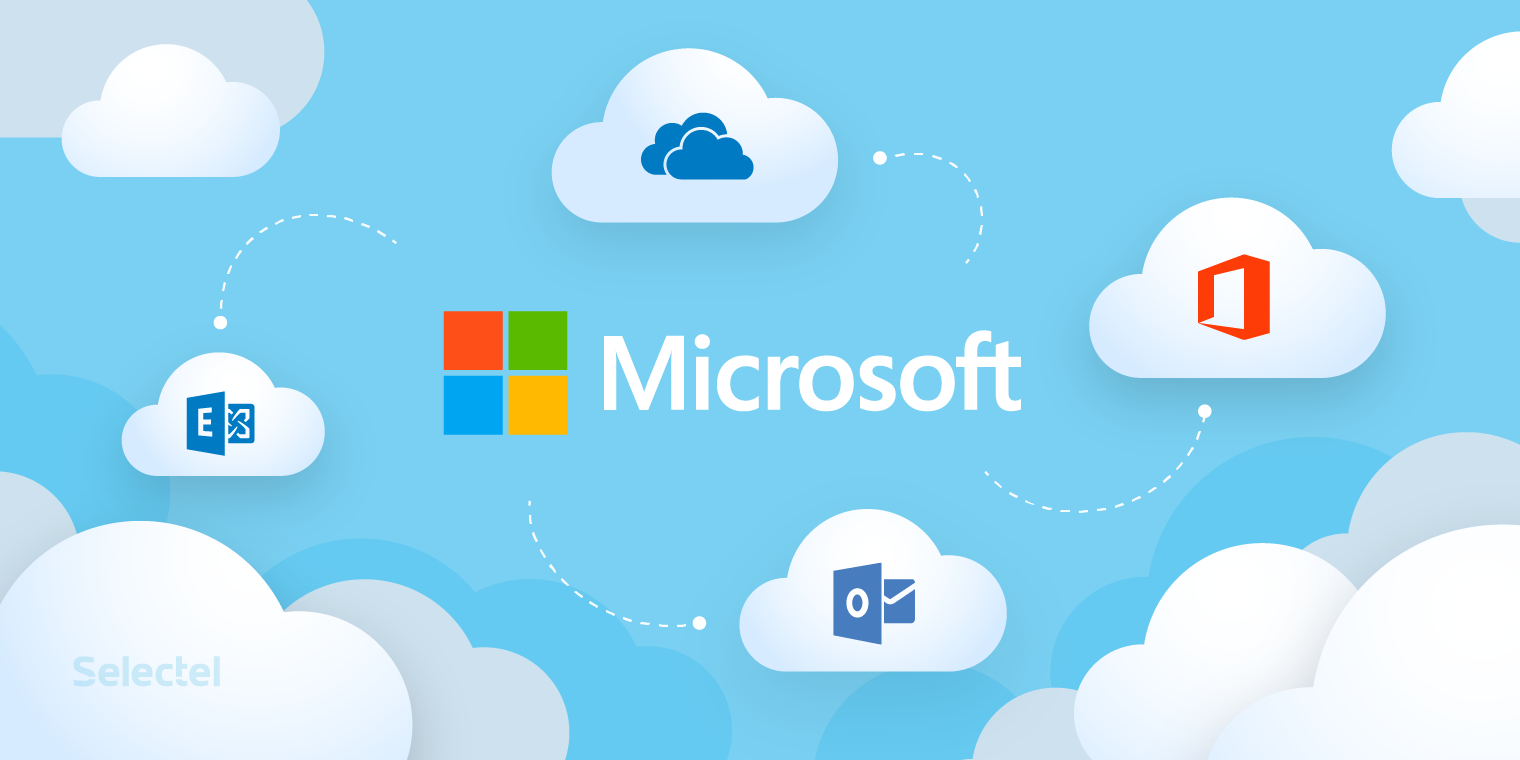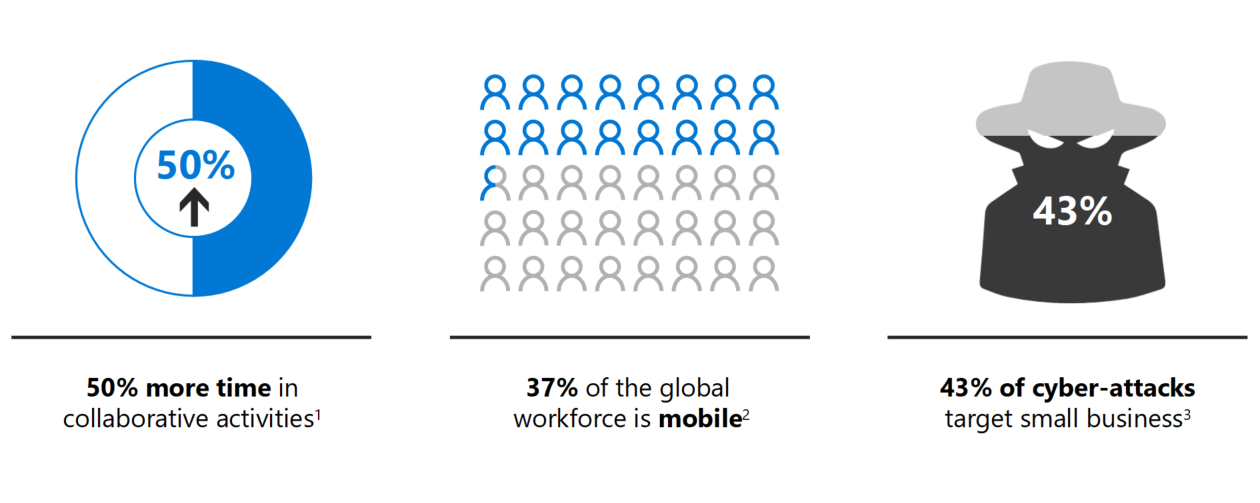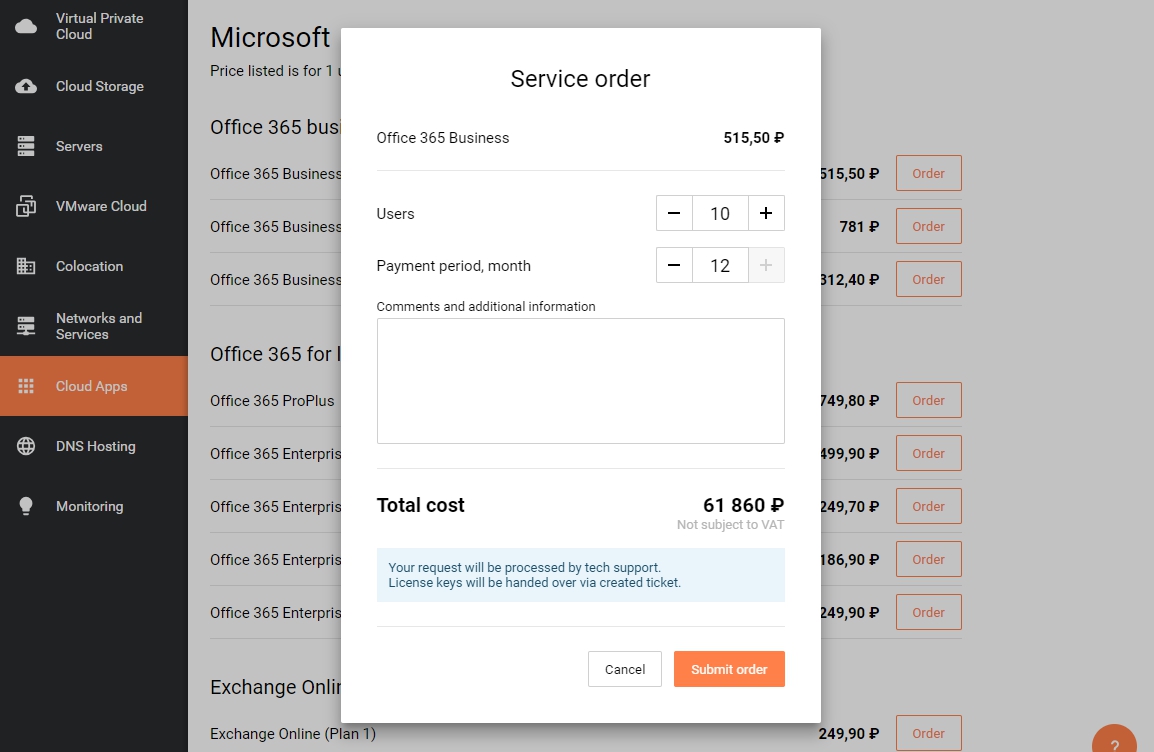Microsoft Cloud Applications
 A lot of clients have already noticed a new service in our control panel: Cloud apps. In this article, we’ll look at the most popular Microsoft cloud services, including Office 365, Exchange Online, Azure Active Directory, OneDrive, and more. We’ll also dispel the most common doubts people have about transferring to the cloud.
A lot of clients have already noticed a new service in our control panel: Cloud apps. In this article, we’ll look at the most popular Microsoft cloud services, including Office 365, Exchange Online, Azure Active Directory, OneDrive, and more. We’ll also dispel the most common doubts people have about transferring to the cloud.
Against the backdrop of constant scientific and technical progress, business development may only be possible in companies that are open to continuous updates and innovation. Today’s IT developers have created new standards for competing workplaces, such as mobile and remote work options, the ability to collaborate on group projects, and effective interaction between company employees. While initially setting up your own work services, like e-mail, is tedious and costly, they also require continuous upkeep and maintenance.
 Small and medium business trends
Small and medium business trends
1 Harvard Business Review, January-February Issue 2016, “Collaborative Overload”
2 Strategic Analytics, Global Mobile Workforce Forecast, 2015-2020, November 2015
3 Small Business Trends, CYBER SECURITY STATISTICS – Numbers Small Businesses Need to Know, Jan. 3, 201
On-premise solutions certainly offer their own advantages, hence why businesses choose them: no subscription payments, flexible configurations, and the sense that your data is secure. This approach is also considered traditional and thus more reliable. What’s practical, however, is not applying specific technologies to your business, but optimizing existing processes and taking the organization to a new level.
The digital transformation of the economy impacts every company, regardless of size. Technical progress opens new options and niches for business development, but it also raises competition and the requirements for what tools are used in an organization. By following digital transformation trends, companies have exhausted their resources and even stunted growth. When it comes to business tools, finding the right balance between cost and effectiveness is one of the key factors of success. In searching for the ideal instrument, companies look at functionality, installation and service costs, as well as product security.
Security
Managing your own infrastructure creates a lot of work for an organization’s IT department and requires a systematic approach to system maintenance. Paying an individual or department to maintain an up-to-date and secure version of an operational service could put a major strain on the company budget. The task of setting up secure storage for confidential data plus backup and restoration services spends a great deal of time in limbo; security is often overlooked while priority is given to quickly acquiring the tools necessary for critical processes.
Companies are always faced with a number of questions that inevitably determine their success:
- Is data fully backed up and are restoration mechanisms in place?
- Have security policies been defined for personal data storage? Is the data sent between employees encrypted and secure?
- Have custom access rules to important company information been configured and data integrity provided for?
- Are software update and vulnerability removal procedures in place?
If a company manages a solution itself, the employees are responsible for answering all of these questions. In this case, it’s up to the organization to recognize if it has the resources and abilities this requires.
 Example of a threat protection mechanism
Example of a threat protection mechanism
Cloud apps already include data and process security systems; the software is always up-to-date and doesn’t require constant monitoring from the company. By using cloud-based solutions, you can instantly get started with professional tools without running the risk of losing time or data.
Cost
Another important factor when choosing your platform is installation and maintenance costs. Cloud apps let you quickly handle business processes with reliable tools: office suites, storage, and additional applications—everything you need without spending extra for server licenses, computing power, or administration.
With cloud services, internal systems are managed by Microsoft. Their specialists ensure your documents are always available and data is reliably stored. Monthly maintenance fees for cloud services are low compared to self-managed solutions thanks to their wholesale model; Microsoft administers all of their cloud clients while guaranteeing a high level of security and service.
New solutions should be implemented with the goal of optimizing current or creating new business processes. The choice for one technology over another is determined by a number of factors: corporate culture, management mechanisms, and additional requirements. How effective a team interacts is often determined by the tools it uses, which in turn influence the employees’ lifestyle—like remote and mobile work options. Microsoft considered the experience of various-sized organizations all over the world when developing their cloud-based apps; this opens your company up to a world of possibilities for growth and development.
Capabilities
Let’s look at the most popular and affordable cloud products today. The most well-known products would be office applications: from spreadsheet editors to e-mail clients. Cloud technology ensures employees are always viewing the latest version of their documents, which synchronize across devices. Additionally, there’s always a copy in the cloud, which can be restored at any time.
 Access data from any device
Access data from any device
Office365 lets you install office applications on five PCs, five smartphones, and five tablets (that’s up to 15 devices). Data is synchronized across devices in the cloud, guaranteeing secure access to information at home and on the road.
Real-time access to the latest information ensures the effective work of geographically diverse groups and branches. Joint access to information and videoconferencing lets you reduce travel costs and employees spend their time more rationally.
With Active Directory, you can integrate and combine various authentication services for organizing user access to resources. Using one login, users can launch any of their cloud applications from a personalized web-based access panel anywhere in the world. Active Directory also lets you securely collaborate with partners and clients from other organizations, regardless of their size or if they even have an IT department. Shared access to company applications and data still enforces authentication policies; partners can use their own login information without any additional complicated setup.
Getting Started
Selectel offers a wide range of services for connecting, configuring, and integrating cloud applications. We’d be happy to help you choose the best tools for your business and will walk you through every step of the way.
 Order Office365 from the control panel
Order Office365 from the control panel
You can get started with Office365 and try other cloud applications today — just submit a request from the control panel or fill out the form on our site, where you’ll also find additional information. Afterwards, a service manager will get in touch with you to iron out the details and provide you the necessary access information.
The time it takes to set up a cloud application depends on the extra work required, such as migrating data from your current system to the cloud. For a new businesses, you will immediately appreciate how simple it is to manage apps and use the familiar interface. When transferring from similar office systems, a wide range of migration tools is available to help move existing infrastructures.